Mercury 11kva Solar Hybrid 3 Phase Inverter Connection
In today’s world, reliable and efficient power solutions are crucial, especially in regions where grid power is unstable. The Mercury 11kva Solar Hybrid Inverter is a powerful single-phase inverter designed to work both independently and in parallel with other units. This flexibility allows multiple units to work together as one cohesive system, providing the benefits of a Solar Hybrid 3 Phase Inverter Connection. This article will explain how you can achieve a Solar Hybrid 3 Phase Inverter Connection using three units of the Mercury 11kva Solar Hybrid Inverter, explore different inverter configurations, and highlight the connection process and benefits.
Parallel Connection: Expanding Power with Multiple Units
The Mercury 11kva Solar Hybrid Inverter has the unique ability to be connected in parallel with other identical units. This feature is particularly beneficial when higher power capacity or a Solar Hybrid 3 Phase Inverter Connection is required. By connecting multiple units in parallel, you essentially create a system where each inverter handles a portion of the load, working together to provide seamless and reliable power distribution.
Different Inverter Configurations: A Flexible Power Solution
The Mercury 11kva Solar Hybrid Inverter can be configured in several ways, depending on your power needs. Here are some key configurations:
1. Single-Phase, Multiple Inverters (Up to Six Units)
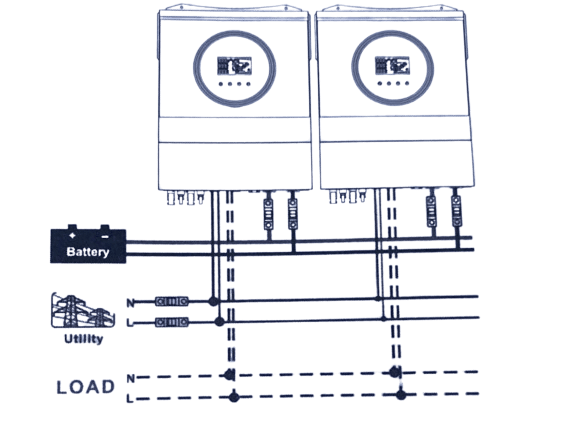
- This configuration allows up to six inverters to be connected in parallel on a single phase.
- It’s ideal for applications requiring increased power capacity without needing a Solar Hybrid 3 Phase Inverter Connection.
- The load is shared across all the inverters, ensuring efficient distribution and better performance under higher demands.
2. Three-Phase, Three Inverters (One Inverter per Phase)
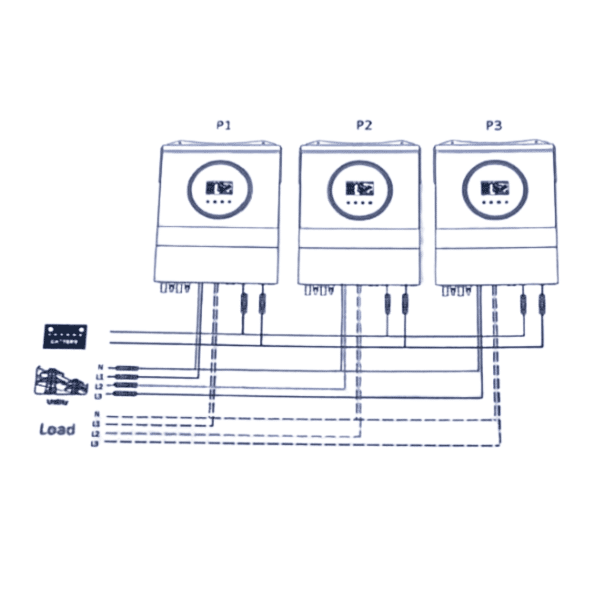
- For a standard Solar Hybrid 3 Phase Inverter Connection, three inverters are used, with each inverter dedicated to one phase (R, Y, B).
- This configuration ensures balanced load distribution across all three phases, making it suitable for most residential or small commercial applications.
3. Three-Phase, Four Inverters (Two Inverters in One Phase)
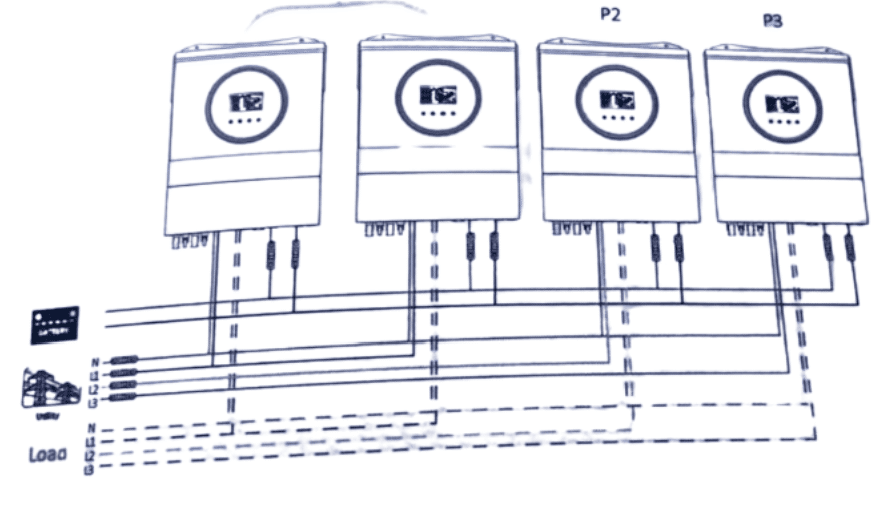
- In this setup, one phase (e.g., Phase R) has two inverters connected in parallel, while the other two phases (Y and B) each have one inverter.
- This configuration is beneficial when one phase consistently has a higher load demand and needs additional power support.
4. Three-Phase, Five Inverters (Three Inverters in One Phase)
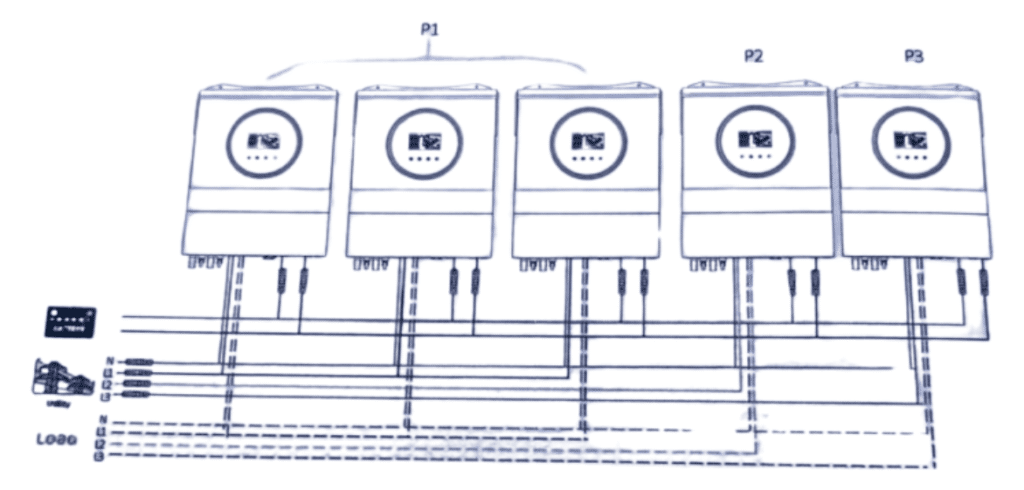
- Here, three inverters are connected to one phase (e.g., Phase R), while the other two phases (Y and B) have one inverter each.
- This is ideal for scenarios where a specific phase requires significantly more power, such as powering large industrial equipment.
5. Three-Phase, Six Inverters (Balanced Load Across Phases)
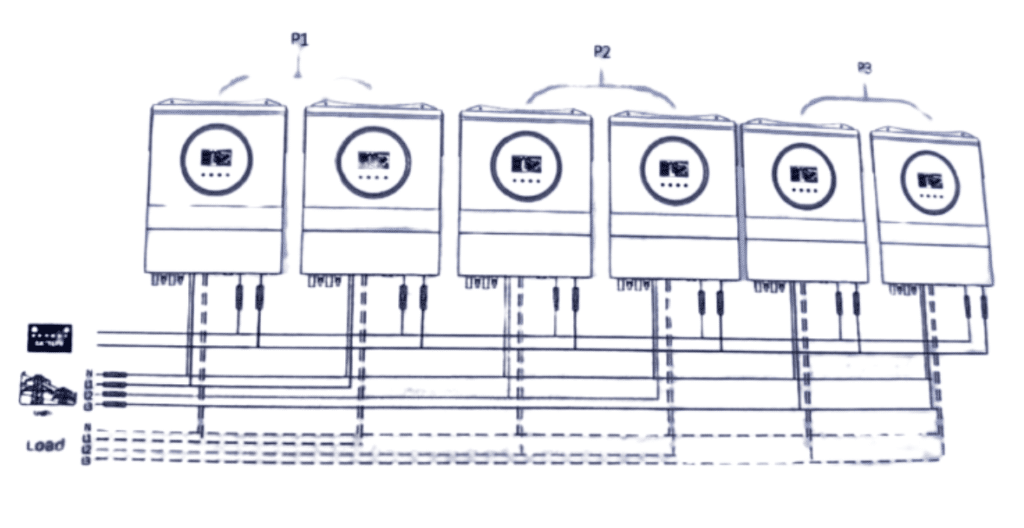
- This setup features two inverters per phase, providing a balanced and robust Solar Hybrid 3 Phase Inverter Connection.
- It’s suitable for larger commercial or industrial applications where high power demand is distributed evenly across all phases.
These configurations provide flexibility, allowing you to tailor the setup to your specific power requirements. The Mercury 11kva Solar Hybrid Inverter is adaptable, offering a solution for a variety of power needs.
Understanding the 3-Phase Connection with Single-Phase Inverters
To achieve a Solar Hybrid 3 Phase Inverter Connection using the Mercury 11kva Solar Hybrid Inverter, you will need three separate units of the single-phase inverter. Each unit will be dedicated to one of the three phases: R (Red), Y (Yellow), and B (Blue). This setup allows the system to handle higher loads and is commonly used in industrial and commercial settings.
How the Solar Hybrid 3 Phase Inverter Connection Works with Three Single-Phase Inverters
- Phase Assignment: Each of the three Mercury 11kva Solar Hybrid Inverters is assigned to one phase of the Solar Hybrid 3 Phase Inverter Connection. For instance:
- The first inverter is connected to Phase R (Red),
- The second inverter is connected to Phase Y (Yellow),
- The third inverter is connected to Phase B (Blue).
- Balanced Load Distribution: With each inverter handling one phase, the load is distributed across all three phases, ensuring balanced current flow and reducing the risk of overloading any single phase.
- Increased Power Capacity: By using three single-phase inverters in a Solar Hybrid 3 Phase Inverter Connection, the system can support higher power demands, making it suitable for larger applications.
- Synchronization and Communication: The inverters are synchronized to work together, ensuring that the power delivered across all three phases is consistent and reliable. Proper communication connections between the inverters help them function cohesively.
- Wiring and Battery Connections: It’s essential to ensure that all battery cables are of the same length to avoid voltage differences between the inverters, which could disrupt the parallel operation.
Step-by-Step Guide to Connecting the Mercury 11kva Solar Hybrid Inverters in a Solar Hybrid 3 Phase Inverter Connection
Step 1: Preparation
Before beginning the installation, ensure that you have all the necessary components and tools. This includes cables, circuit breakers, protective gear, and three Mercury 11kva Solar Hybrid Inverters.
Step 2: Phase Connection
- Assign Inverters to Phases: Designate each of the three inverters to a specific phase: R, Y, and B.
- Wiring the Phases: Connect each inverter to its corresponding phase in your electrical distribution board using appropriate cables.
Step 3: Battery Connection
- Battery Bank Setup: Connect each inverter to a separate battery bank or a shared battery system, ensuring correct polarity. Ensure that the battery cables are of equal length for each inverter to prevent voltage discrepancies.
Step 4: Solar Panel Connection
- Connect Solar Panels: Use the solar input terminals on each inverter to connect your solar panel array. Ensure that the panels are properly configured for the system’s voltage and current requirements. Note that each inverter should be connected to PV modules separately.
Step 5: Grid Connection
- Grid Tie-In: Connect each inverter to the grid supply. This allows the inverters to switch between solar, battery, and grid power as needed.
Step 6: Testing and Commissioning
- Power On: Turn on the inverters and check all connections.
- Load Testing: Gradually apply load to ensure the system handles the power distribution correctly across all phases.
- Monitoring: Use the inverters’ displays or mobile apps to monitor the system’s performance.
Benefits of Using Mercury 11kva Solar Hybrid Inverters in a Solar Hybrid 3 Phase Inverter Connection
- Energy Efficiency: The hybrid system ensures that you use the most cost-effective energy source available, reducing your electricity bills.
- Reliability: With a Solar Hybrid 3 Phase Inverter Connection and battery backup, you can be assured of a continuous power supply, even during outages.
- Scalability: The system can be expanded by adding more solar panels or batteries, making it suitable for future energy needs.
- Environmentally Friendly: By using solar power, you reduce your carbon footprint and contribute to a cleaner environment.
Common Applications of the Mercury 11kva Solar Hybrid Inverter
- Residential Homes: Ideal for large homes with high energy demands.
- Small Businesses: Perfect for businesses that require reliable power for equipment and operations.
- Industrial Use: Suitable for powering heavy machinery and equipment in factories or workshops.
Conclusion
The Mercury 11kva Solar Hybrid Inverter is an excellent choice for anyone looking to improve their energy efficiency and reliability. By using three units in a Solar Hybrid 3 Phase Inverter Connection or other configurations as needed, you can handle higher loads and ensure consistent power distribution across all phases. Whether you’re upgrading your current system or installing a new one, the Mercury 11kva Solar Hybrid Inverter is a smart investment for a sustainable and reliable power solution.
For more information on the Mercury 11kva Solar Hybrid Inverter or to explore our other products, visit mercurydirect.com.ng.
You can also read more about optimizing your energy systems in our blog: Powering Your World: The Mercury Direct Blog.
Frequently Asked Questions (FAQ) about Solar Hybrid 3 Phase Inverter Connection
1. What is a Solar Hybrid 3 Phase Inverter Connection?
A Solar Hybrid 3 Phase Inverter Connection involves using multiple single-phase inverters to create a 3-phase power system. This setup allows for higher power capacity and is ideal for residential, commercial, and industrial applications where reliable and balanced power distribution is essential.
2. How many inverters do I need for a Solar Hybrid 3 Phase Inverter Connection?
To create a Solar Hybrid 3 Phase Inverter Connection, you need at least three Mercury 11kva Solar Hybrid Inverters. Each inverter will be connected to one of the three phases (R, Y, B) to ensure balanced power distribution across all phases.
3. Can I connect more than three inverters in a 3-phase setup?
Yes, you can connect up to six inverters in various configurations depending on your power needs. For example, you can have two inverters per phase for higher power requirements or different configurations like having two or three inverters in a single phase while others have one.
4. What are the benefits of using a Solar Hybrid 3 Phase Inverter Connection?
The benefits include increased energy efficiency, reliable power supply even during outages, scalability for future energy needs, and an environmentally friendly solution by maximizing the use of solar energy.
5. How do I ensure balanced load distribution in a 3-phase connection?
Balanced load distribution is achieved by assigning each inverter to a specific phase (R, Y, B) and ensuring the load is evenly distributed across all three phases. Proper synchronization and communication between the inverters are crucial to maintain this balance.
6. Can I use a Solar Hybrid 3 Phase Inverter Connection for my business?
Yes, a Solar Hybrid 3 Phase Inverter Connection is highly suitable for small businesses, industrial applications, and any setting that requires a stable and reliable power supply. It’s particularly beneficial for businesses with heavy machinery or equipment that demand consistent power.
7. How do I connect solar panels to a Solar Hybrid 3 Phase Inverter system?
Each inverter in the system should be connected to its own set of solar panels. This ensures that each phase is independently powered by solar energy, optimizing the efficiency and reliability of the entire system.
8. What kind of maintenance is required for a Solar Hybrid 3 Phase Inverter Connection?
Regular maintenance includes checking the connections, ensuring battery health, and monitoring the inverter system for optimal performance. It’s also important to keep the solar panels clean and properly aligned to maximize energy generation.
9. Can I expand my Solar Hybrid 3 Phase Inverter system in the future?
Yes, the system is highly scalable. You can add more solar panels or batteries to increase the power capacity, making it a future-proof solution for growing energy needs.
10. Where can I buy Mercury 11kva Solar Hybrid Inverters?
You can purchase Mercury 11kva Solar Hybrid Inverters directly from Mercury Direct. For more detailed guidance on choosing the right inverter for your needs, explore our blog: Powering Your World: The Mercury Direct Blog.


I want to connect three 11Kw Inverter per phase, making it a total of 9 units. Lets Chat (Mr. Olalando)